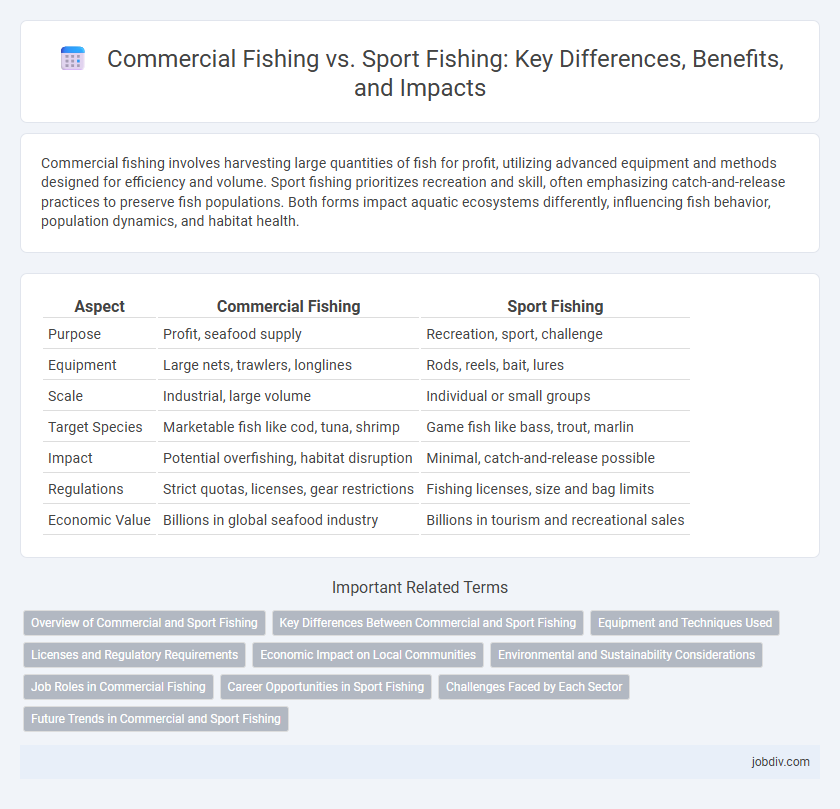Commercial fishing involves harvesting large quantities of fish for profit, utilizing advanced equipment and methods designed for efficiency and volume. Sport fishing prioritizes recreation and skill, often emphasizing catch-and-release practices to preserve fish populations. Both forms impact aquatic ecosystems differently, influencing fish behavior, population dynamics, and habitat health.
Table of Comparison
| Aspect | Commercial Fishing | Sport Fishing |
|---|---|---|
| Purpose | Profit, seafood supply | Recreation, sport, challenge |
| Equipment | Large nets, trawlers, longlines | Rods, reels, bait, lures |
| Scale | Industrial, large volume | Individual or small groups |
| Target Species | Marketable fish like cod, tuna, shrimp | Game fish like bass, trout, marlin |
| Impact | Potential overfishing, habitat disruption | Minimal, catch-and-release possible |
| Regulations | Strict quotas, licenses, gear restrictions | Fishing licenses, size and bag limits |
| Economic Value | Billions in global seafood industry | Billions in tourism and recreational sales |
Overview of Commercial and Sport Fishing
Commercial fishing involves large-scale harvesting of fish and seafood primarily for profit, utilizing advanced equipment such as trawlers, longlines, and gillnets to capture vast quantities efficiently. Sport fishing, also known as recreational fishing, focuses on leisure and competition, often regulated to ensure sustainable fish populations through catch-and-release practices and size limits. Both methods impact marine ecosystems differently, with commercial fishing driving economic markets while sport fishing supports tourism and conservation efforts.
Key Differences Between Commercial and Sport Fishing
Commercial fishing targets large-scale harvests using boats, nets, and traps designed for maximum yield to supply seafood markets, emphasizing efficiency and sustainability regulations. Sport fishing prioritizes recreational angling, often involving catch-and-release practices, focusing on skill, conservation, and enjoyment rather than volume. Key differences include purpose, techniques, equipment scale, and regulatory frameworks governing each activity to balance economic needs with environmental impact.
Equipment and Techniques Used
Commercial fishing employs large-scale equipment such as trawl nets, longlines, and seiners designed for high-volume catch efficiency, often using GPS and sonar technology for tracking fish schools. Sport fishing relies on lighter gear like rods, reels, artificial lures, and bait, emphasizing techniques such as fly fishing, trolling, and casting to target specific species for recreational purposes. Both methods utilize specialized tools, but commercial fishing prioritizes mass harvesting while sport fishing focuses on skillful catch-and-release practices.
Licenses and Regulatory Requirements
Commercial fishing requires extensive licensing and strict adherence to regulatory requirements, including quotas, gear restrictions, and seasonal limitations to ensure sustainable fish populations. Sport fishing licenses are typically more affordable and impose limits on catch sizes, species, and fishing locations to balance recreational enjoyment with conservation efforts. Regulatory agencies such as NOAA Fisheries and state fish and wildlife departments enforce these rules to protect marine ecosystems and promote responsible fishing practices.
Economic Impact on Local Communities
Commercial fishing significantly contributes to local economies by providing employment opportunities and supporting ancillary industries such as processing and transportation, generating billions in revenue annually. Sport fishing drives economic impact through tourism, attracting enthusiasts who spend on lodging, gear, and guided trips, thereby boosting small businesses in coastal areas. Both sectors create vital economic ecosystems, with commercial fishing emphasizing large-scale supply chains and sport fishing fostering recreational and hospitality services.
Environmental and Sustainability Considerations
Commercial fishing heavily impacts marine ecosystems through overfishing, habitat destruction, and bycatch, threatening fish populations and biodiversity. Sport fishing, while often more regulated and targeted, can still contribute to environmental stress if catch limits and ethical practices are not strictly followed. Sustainable fishing practices, such as size and quota restrictions, catch-and-release policies, and habitat conservation, are crucial for minimizing ecological damage in both commercial and sport fishing sectors.
Job Roles in Commercial Fishing
Commercial fishing involves specialized job roles such as deckhands who handle nets and lines, captains who navigate and manage fishing vessels, and processors who sort and prepare catches for market. These roles require extensive knowledge of marine ecosystems, safety protocols, and equipment operation to maximize yield and ensure sustainability. Unlike sport fishing, which emphasizes recreational experience, commercial fishing centers on large-scale harvest and supply chain efficiency.
Career Opportunities in Sport Fishing
Sport fishing offers diverse career opportunities including roles such as fishing guides, charter boat operators, and fishing gear designers. These professions often require deep knowledge of fish behavior, local ecosystems, and advanced angling techniques. Unlike commercial fishing, sport fishing careers emphasize customer interaction and sustainable fishing practices, creating a dynamic work environment with potential for entrepreneurship.
Challenges Faced by Each Sector
Commercial fishing faces challenges such as overfishing regulations, bycatch reduction, and maintaining sustainable fish populations while meeting high market demand. Sport fishing encounters difficulties including limited fishing seasons, catch-and-release ethics, and balancing recreational angler satisfaction with conservation efforts. Both sectors must address environmental impacts and compliance with fisheries management policies to ensure the longevity of aquatic ecosystems.
Future Trends in Commercial and Sport Fishing
Advancements in technology and sustainable practices are shaping the future of commercial fishing, with increased use of AI-driven sonar systems and eco-friendly gear to minimize environmental impact. Sport fishing is seeing growth through virtual reality experiences and enhanced catch-and-release techniques that promote conservation and fish population recovery. Both sectors are integrating data analytics to improve resource management and ensure long-term ecosystem health.
Commercial Fishing vs Sport Fishing Infographic

 jobdiv.com
jobdiv.com